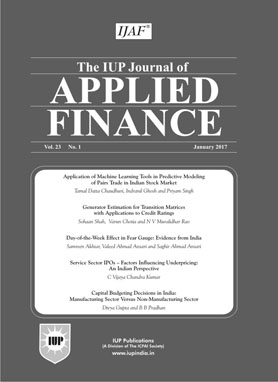
MAr' 2021
Case Folio
The IUP Journal of Management Case Studies
Archives
Taiwan: A Global Model for Combatting the Covid-19 Crisis
The case discusses the measures taken by the Taiwanese government to tackle the COVID-19 crisis. Despite its close geographic proximity to China, where the outbreakbegan, Taiwan had limited its cases to just 443 as of May 30, 2020, with only seven deaths. Taiwan with its speedy,efficient, and expert-led response, has thus become a role model in combating thepandemic globally, despite its exclusion from the World Health Organization(WHO). The case highlights the lessons the world could learn from Taiwan’s successful response to the COVID-19 crisis, particularly the “5 Ts”: transparency, transportation controls,tracking, testing, and technology. After its success in containing the coronavirus outbreak, analysts wondered whether Taiwan would be invited to join the WHO so that the global community would get more opportunities to learn about the country’s epidemic prevention model and healthcare expertise. Also, it remained to be seen whether Taiwan would be able to maintain its robust pandemic prevention policies until the end of the pandemic. more »
Pinduoduo Inc.: Turning the Covid-19 Crisis into an Opportunity
The case is about Chinese e-commerce company Pinduoduo Inc.’s (PDD) strategy before and during the Covid-19 pandemic. Founder Colin Huang Zheng (Colin) described PDD as a combination of Costco and Disney, i.e., the company combined bargain products with entertainment. China, being the epicenter of the Covid-19 pandemic, witnessed a disruption in businesses and supply chains across the country through factory closures, roadblocks and mandatory quarantines. Farmers in China too faced difficulties selling their farm produce as large agricultural wholesale markets were closed down in a bid to contain the spread of Covid-19. PDD took this as an opportunity and leveraged its strength of being one of the largest e-commerce online platforms for agricultural products in China. In February 2020, the company launched a ‘Help the Farmers’ campaign wherein it collected information about surplus agricultural products and connected farmers with consumers through its online platform, live-streaming the perishable stock. While PDD supported farmers, merchants, employees and consumers during the outbreak of Covid-19, it also offered business subsidies and medical supplies, and donated funds. Going forward, PDD aimed to digitize agriculture in a bid to capitalize on the rising demand from consumers for safe and reliable produce in the wake of the pandemic. The senior management team at PDD had the onerous task of tapping this opportunity to fuel post-Covid-19 growth. more »
The P&G-Merck KGaA Consumer Health Business Merger
The case discusses the M&A deal between the Germany-based global pharmaceutical company Merck KGaA and the US-based, multinational FMCG company P&G. In this deal, P&G acquired a 100% stake in the consumer health business of Merck KGaA for $4.2 bn. The case helps the students understand the various aspects of an M&A deal. It explores the rationale behind the merger deal, from both P&G’s and Merck KGaA’s perspective. It discusses the various developments that took place before and after the merger was announced. It provides sufficient scope to debate the various possible synergies and various challenges related to this deal. The case ends with a debate on whether the merger would be successful or not. more »
The Reset Button Pushed by Forever 21
Forever 21, a US-based fashion retail brand headquartered in Los Angeles, California, was started by a South Korean immigrant couple, Jin Sook and Do Won Chang, in 1984. Forever 21 was a forerunner in the fast fashion industry and, spurred by its initial success, it started opening new stores at frequent intervals. But on September 29, 2019, Forever 21 filed for Chapter 11 bankruptcy protection to restructure its business. The company said, “We do however expect a significant number of these stores will remain open and operate as usual, and we do not expect to exit any major markets in the US.” The company had 549 stores in the US and 251 stores in other countries at the time of filing bankruptcy. The company said it planned to “exit most international locations in Asia and Europe” but would continue to operate in Mexico and Latin America. It was expected to close up to 350 stores worldwide, including 178 stores in the US. A Forever 21 spokesperson said the retailer expected to have between 450 and 500 stores globally after this process. The case discusses the origin and growth of Forever 21, and the factors that led to its downfall—rapid expansion, global recession, retail apocalypse, and changing consumer preferences. more »